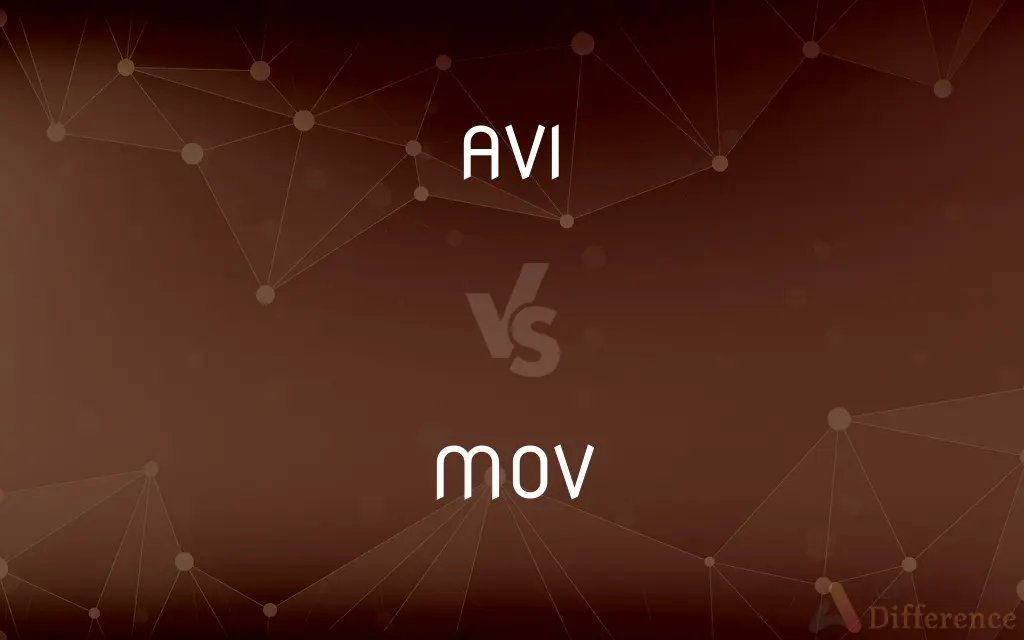AVI vs. MOV — What's the Difference?
By Tayyaba Rehman & Urooj Arif — Published on February 16, 2024
AVI (Audio Video Interleave) is a multimedia container format by Microsoft, known for less compression. MOV (QuickTime File Format) is developed by Apple, offering higher compression and compatibility with Apple devices.

Difference Between AVI and MOV
Table of Contents
ADVERTISEMENT
Key Differences
AVI and MOV are two popular digital video file formats, each with distinct characteristics and uses. AVI, which stands for Audio Video Interleave, is a multimedia container format introduced by Microsoft. It allows synchronous audio-with-video playback and is known for its simplicity and wide compatibility with various media players and devices. AVI files can contain both audio and video data in a file container that allows synchronous audio-with-video playback.
MOV, on the other hand, is a file format used by Apple's QuickTime multimedia software. It is also a container format that can hold various types of multimedia, including video, audio, text, and effects. MOV files are known for their high quality and flexibility, supporting a wide range of codecs. They are particularly optimized for Apple devices and software but can also be played on other platforms with appropriate software.
One key difference between AVI and MOV files is their approach to compression and quality. AVI files are less compressed, which can result in larger file sizes but potentially less loss of quality. MOV files, while also capable of maintaining high quality, are generally more compressed, making them more suitable for use on the internet or in environments where storage space is a concern.
Compatibility is another factor distinguishing the two formats. AVI's broad support across various operating systems and devices makes it a go-to choice for ensuring accessibility and playback capability. MOV files, optimized for Apple's ecosystem, offer seamless integration and performance on Macs and iOS devices but might require additional software for playback on non-Apple devices.
In summary, both AVI and MOV formats have their advantages, with AVI being favored for its compatibility and simplicity, and MOV preferred for its high quality and efficiency, especially within the Apple ecosystem. The choice between them often depends on the specific requirements of the project, including intended audience, playback platforms, and quality considerations.
ADVERTISEMENT
Comparison Chart
Developer
Microsoft
Apple
Compression
Less compressed, larger files
Higher compression, more efficient storage
Quality
Can maintain high quality
High quality, especially with Apple codecs
Compatibility
Wide compatibility across platforms
Optimized for Apple devices, playable elsewhere with QuickTime or converters
Usage
Common for storing and playing video on PCs
Preferred for editing and playback in Apple software
Compare with Definitions
AVI
Widely supported across media players.
The AVI file played seamlessly on my media player.
MOV
A multimedia container format developed by Apple.
I exported the film as a MOV file for editing in Final Cut Pro.
AVI
A multimedia container format by Microsoft.
I saved the video in AVI format for broad compatibility.
MOV
Supports a wide range of codecs.
The MOV format accommodates various codecs for video and audio.
AVI
Less compressed to maintain quality.
We chose AVI to avoid losing video quality after compression.
MOV
Optimized for use on Apple devices.
MOV files work best on my MacBook and iPhone.
AVI
Known for synchronous audio-with-video playback.
AVI files ensure the video and audio are perfectly synced.
MOV
Ideal for professional video editing and production.
For professional projects, MOV is my go-to format.
AVI
Suitable for storing high-quality video on PCs.
For archiving, I prefer using AVI for its high-quality storage.
MOV
Offers high-quality video in a compressed form.
Despite compression, the MOV file maintained excellent quality.
Common Curiosities
Which format is better for Windows users, AVI or MOV?
AVI is generally more compatible with Windows environments.
Can AVI and MOV files contain subtitles?
Yes, both formats can support subtitles within the container.
Which format is more suitable for online streaming?
MOV can be more efficient due to better compression options.
Which format should I use for video editing on a Mac?
MOV is preferred for its integration with Apple's editing software.
Is there a quality difference between AVI and MOV?
Quality can vary based on compression and codecs used, rather than the container format itself.
How can I convert AVI to MOV or vice versa?
Use video conversion software or online services for format conversion.
Do AVI files work on Apple devices?
They can, but might require a compatible media player app.
Is AVI a good choice for archival purposes?
Yes, due to its less compressed nature and wide compatibility.
Are AVI files larger than MOV files?
Typically, yes, due to less compression in AVI format.
Can I play MOV files on a PC without QuickTime?
Yes, with compatible media players like VLC or through conversion.
Are MOV files easier to edit than AVI files?
On Apple devices and software, MOV files are often easier to edit.
Can both formats support 4K video?
Yes, both AVI and MOV can handle 4K content with the right codecs.
Which format offers better compatibility with non-linear editing systems?
MOV is generally favored in professional editing environments.
Can I email AVI or MOV files directly?
Due to file size, it's often better to use cloud services or file compression before sharing via email.
Do all media players support AVI and MOV formats?
Most popular media players do, but compatibility can vary.
Share Your Discovery

Previous Comparison
Liposomal Glutathione vs. Reduced Glutathione
Next Comparison
LiAlH4 vs. NaBH4Author Spotlight
Written by
Tayyaba RehmanTayyaba Rehman is a distinguished writer, currently serving as a primary contributor to askdifference.com. As a researcher in semantics and etymology, Tayyaba's passion for the complexity of languages and their distinctions has found a perfect home on the platform. Tayyaba delves into the intricacies of language, distinguishing between commonly confused words and phrases, thereby providing clarity for readers worldwide.
Co-written by
Urooj ArifUrooj is a skilled content writer at Ask Difference, known for her exceptional ability to simplify complex topics into engaging and informative content. With a passion for research and a flair for clear, concise writing, she consistently delivers articles that resonate with our diverse audience.
















































